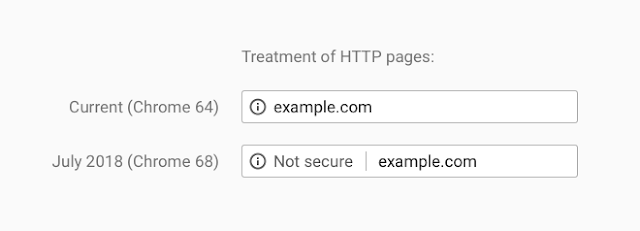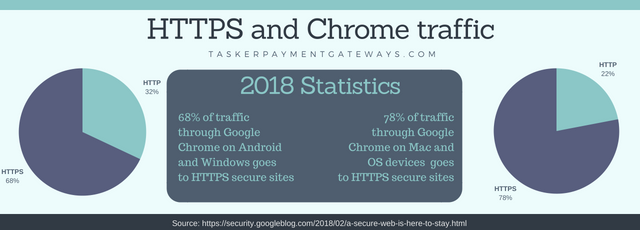HTTPS is now an absolute must for high-risk e-commerce SEO
There’s some fairly big SEO news just around the corner that should be of concern to all online high-risk merchants: Google’s web browser, Chrome, will mark all non-HTTPS sites as “not secure” as of July 2018. Some of you might wonder why this news is significant. It is correct that Google has been identifying non-HTTPS sites for a while now, we even discussed it in January of 2018. However, this new security warning implementation is distinct– visually speaking. Additionally, of the recent developments in Google search, ensuring the safety of sensitive information is right up there with the prioritization of mobile-friendly websites.
You can see the visual change about to happen below. We were given permission by Emily Schechter, Chrome Security Product Manager, to borrow the image directly from the Google Blog post “A secure web is here to stay.”

As you can see, there was previously a visual difference between secure and unsecured pages. However, the move now is to further highlight the fact that a site is not secure. This may seem like a small change, but there are multiple aspects that make it significant. It’s about trust, which is the heart of e-commerce, it’s about Google ranking, and it’s about taking advantage of this change as its repercussions unfold. All of which should be at the center of your content creation and content marketing activities.
Chrome 68 HTTP warning and trust in high-risk e-commerce
As we’ve already mentioned, trust is the heart of all e-commerce. Visitors need to feel secure and comfortable with your site, your content, and your merchant service functionalities. After all, this is why you’ve worked so hard to ensure that your payment gateway and your merchant account work well and integrate brilliantly with your site and shopping cart. If you need help with establishing a secure payment gateway or merchant account to accept credit cards online, feel free to use the contact form below. Even though we know that trust is a basic building block in e-commerce, there are many online merchants out there that haven’t implemented HTTPS on their online store yet. To emphasize this, let’s invert the numbers from the Google Blog post.
 We can see in the infographic above that a significant amount of traffic on Google Chrome still goes to unprotected sites – 32% from Android and Windows, and 22% from Mac and OS devices. This continues a trend of increased prevalence of traffic going to secure sites. In other words, between a third and a fifth of all traffic currently goes to unprotected sites. In case you haven’t yet implemented HTTPS on your high-risk e-commerce site, we highly recommend you do so as soon as possible. The Chrome 68 update launch is literally just around the corner. The sooner you are ready for it the better.
We can see in the infographic above that a significant amount of traffic on Google Chrome still goes to unprotected sites – 32% from Android and Windows, and 22% from Mac and OS devices. This continues a trend of increased prevalence of traffic going to secure sites. In other words, between a third and a fifth of all traffic currently goes to unprotected sites. In case you haven’t yet implemented HTTPS on your high-risk e-commerce site, we highly recommend you do so as soon as possible. The Chrome 68 update launch is literally just around the corner. The sooner you are ready for it the better.
As a high-risk online merchant, the immediate issue for you here is that Chrome will show your visitors a non-HTTPS warning if your site remains unsecured. This will harm your visitors’ trust in your business and brand. In other words, it might directly affect your lead generation and sales. While many e-commerce sites might be able to compensate for the current warning shown by the Chrome browser, this will likely change. Furthermore, Google will undoubtedly continue to promote HTTPS and secure sites. After all, Google has been promoting secure sites in its algorithm updates since 2014.
High-risk online merchants and ranking in Google
This is where things can get a bit complex. First of all, we need to keep in mind that Google use no less than 200 factors in its algorithm for ranking sites in its search engine results pages (SERPs).
 However, some are more pertinent than others for specific sites. For some high-risk online businesses, ranking in Google can be particularly tricky. Google, similarly to merchant account issuers, is wary of risk. Though rather than worrying about the risk to their financial stakes, Google worries about the potential risk presented to its users. Out of the 200 ranking factors, three updates are particularly important to keep in mind for high-risk merchants. Site security and having HTTPS connections is one of them, first pushed and prioritized in 2014. The other is the iterations of what was dubbed the “PayDay Loan” update from 2013, which targets spammy sites and web pages with spammy ranking signals. However, neither of these are major ranking factors in and of themselves.
However, some are more pertinent than others for specific sites. For some high-risk online businesses, ranking in Google can be particularly tricky. Google, similarly to merchant account issuers, is wary of risk. Though rather than worrying about the risk to their financial stakes, Google worries about the potential risk presented to its users. Out of the 200 ranking factors, three updates are particularly important to keep in mind for high-risk merchants. Site security and having HTTPS connections is one of them, first pushed and prioritized in 2014. The other is the iterations of what was dubbed the “PayDay Loan” update from 2013, which targets spammy sites and web pages with spammy ranking signals. However, neither of these are major ranking factors in and of themselves.
RankBrain, on the other hand, is a big one. After all, Google confirmed that the top 3 ranking factors were links, content, and RankBrain. While they confirmed these as the three main ranking factors, they did not confirm their order of importance. Links and content are the top two, as they specified that RankBrain is number 3 in the equation.
This is where the new, more visual, HTTP warning comes into play. RankBrain is a machine-learning algorithm that is part of the core algorithm Google use to rank pages. In short, it automatically adjusts search results based on user behavior to sites that correspond to specific search queries. Here’s one example: 1,000 people searched “Vape e-liquid” and the searchers visit the number one ranked site. Unfortunately for the site, 900 leave almost immediately. RankBrain will then adjust the search results based on user behavior, comparing the user behavior to other sites visited through the same, or similar, searches. This means that if your online vape store is operating without HTTPS and you experience a drop in traffic in July, a lack of HTTPS is most likely the cause.
As mentioned, this can all become a bit convoluted. In short, RankBrain is the main factor that will affect high-risk online stores’ ranking if HTTPS is not implemented. If you do not have HTTPS implemented on your FFL e-commerce business or premium cigar membership site, and you see an increase in visitors leaving your site immediately (bounce rate as it’s called in SEO lingo), RankBrain is the factor that will deprioritize your site over more secure and user trusted sources down the line.
Taking advantage of a new development
It’s very easy to become worried when changes come around. However, this can actually be a great opportunity to come out on top! After all, as we mentioned earlier, between one-third and one-fifth of all traffic through Chrome goes to unsecured HTTP sites. If you implement HTTPS, you’re already doing better than a significant amount of sites currently getting traffic. You’re exceeding them in one of the three biggest Google ranking factors to boot. In other words, you should use this push by Google to prioritize secure sites to improve your site on a fundamental level. By implementing HTTPS, ensuring you have excellent content, and promoting your site, you will likely find it much easier to boost your link-building activity as a result – thereby hitting the Google ranking trifecta. If you wish to take practical steps to help the search engine optimization (SEO) of your high-risk e-commerce store, this is a great place to start!
Don’t forget, you can always reach us should you need assistance with your high-risk merchant account and payment gateway needs!
